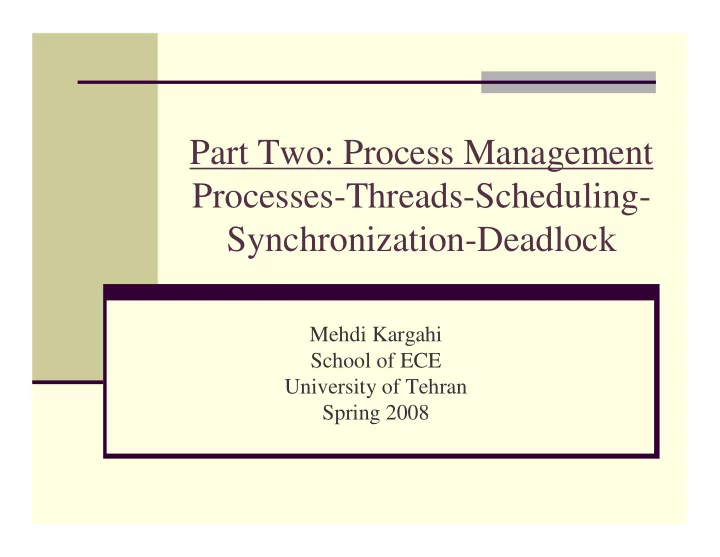

Part Two: Process Management Processes-Threads-Scheduling- Synchronization-Deadlock Mehdi Kargahi School of ECE University of Tehran Spring 2008
Processes � Program : A passive entity � Process : An active entity (a program that is loaded into memory with program counter, resources) � Single-thread vs. multiple-thread processes
Process States
Process Control Block (PCB) � Process state � Program counter � CPU registers � CPU-scheduling information � Memory management information � Accounting information � I/O status information
Process Control Block (PCB)
Context Switch
Process Scheduling � Context switch � Multiple register sets for faster switching in some processors (such as Sun UltraSPARC) � Job queue � Ready queue (as a linked list) � I/O devices queue (linked lists)
Ready Queue and I/O Device Queues
Queueing-Diagram Representation of Process Scheduling Dispatch
Schedulers � Long-term scheduler or job scheduler � Often in a batch system, from the spooled requests � Controls the degree of multiprogramming � Is not present in all operating systems � Should prepare a good mix of I/O-bound and CPU-bound processes � Stability: process creation rate ≤ process completion rate � Short-term scheduler or CPU scheduler � High frequency (e.g., every 10 ms to 100 ms ) � Context switch overhead should be kept low
Schedulers � Some operating systems introduce an intermediate level of scheduling � Medium-term scheduler to dynamically changing the degree of multiprogramming using swapping � Added to the previous queueing diagram
Operations on Processes � Process creation � A parent process may create a several new children processes via specific system calls � Pid: Process identifier � Each process is created by its parent (except the first process) � Possibilities after creating a process � The parent continues execution concurrently with its child � The parent waits until some or all of its childs have terminated � Possibilities in terms of the address space of the new process � The child is a duplicate of the parent (same program & data) � The child process has a new program loaded into it
UNIX Fork System Call
UNIX Fork System Call
Creating a Separate Process using Win32 API
Operations on Processes � Process termination � Calling exit() or aborted by another process (normally its parent) � Cascading termination � The reasons that a parent may terminate its children � The child has exceeded its usage of some of its resources � The child task is no longer required � The parent is exiting (depends on the OS) � VMS (cascading termination) � UNIX (re-parent it)
Process Communication � Independent processes � No shared data � Deterministic and repeatable execution � Cooperative processes � Shared data (normally through shared memory) � Mutual effect on each other � Non-deterministic (stochastic) execution
Example � Producer-Consumer � Shared memory � Message passing � Bounded buffer � Unbounded buffer � Message passing � Direct communication � Indirect communication (mailboxes or ports)
Example � Message passing � Blocking (Synchronous) � Non-blocking (Asynchronous) � Blocking send � Non-blocking send � Blocking receive � Non-blocking receive (returns a valid message or a null) � Buffering � Zero capacity � Bounded capacity � Unbounded capacity
Examples of IPC Systems � POSIX shared memory � Create a shared memory segment � Segment_id = shmget(IPC_PRIVATE, size, S_IRUSR|S_IWUSR) � Attach it to the process address space � Shared_memory = (char *)shmat(id, null, 0) � Accessing the shared memory as a routine memory � Sprintf(shared_memory, “Writing to shared memory”) � When no longer is required: detach the segment � Shmdt(shared_memory);
Other Strategies for Communication in C/S Systems � Sockets � Remote Procedure Call (RPC) � Remote Method Invocation (RMI)
Sockets � IP address specifies the host � Port specifies the communicating process Communicate via a Process-2 pair of sockets Process-1 (IP Add: (IP Add: Port) Port) � Server : listens � Client : creates a socket and requests a connection to the server as IP: Port � Property: unstructured stream of bytes. C & S should know their structures
RPC (Remote Procedure Call) � Structured byte stream as the required information for initiating and doing a procedure call � An RPC daemon which is listening to a port on a remote machine may get a message containing � Identifier of the function to be executed � The parameters which are passed to the function ( marshaled ) � The output is sent back in a separate message � Finding the port of a service in RPC � Predetermined binding information (fixed port address at compile time)- less overhead � Dynamic binding (using rendezvous/matchmaker daemons)- more flexibility
RPC (Remote Procedure Call)
RMI (Remote Method Invocation) � A Java feature (invoking a method on a remote object) � Objects are remote if they are on a different JVM � Client stub marshals the method-name and parameters � Skeleton on the server un-marshals them
RMI (Remote Method Invocation) � If the marshaled parameters are local objects, they are passed by copy using object serialization (writing the state of an object to a byte stream) � If the parameters are remote objects, they are passed by reference
Recommend
More recommend